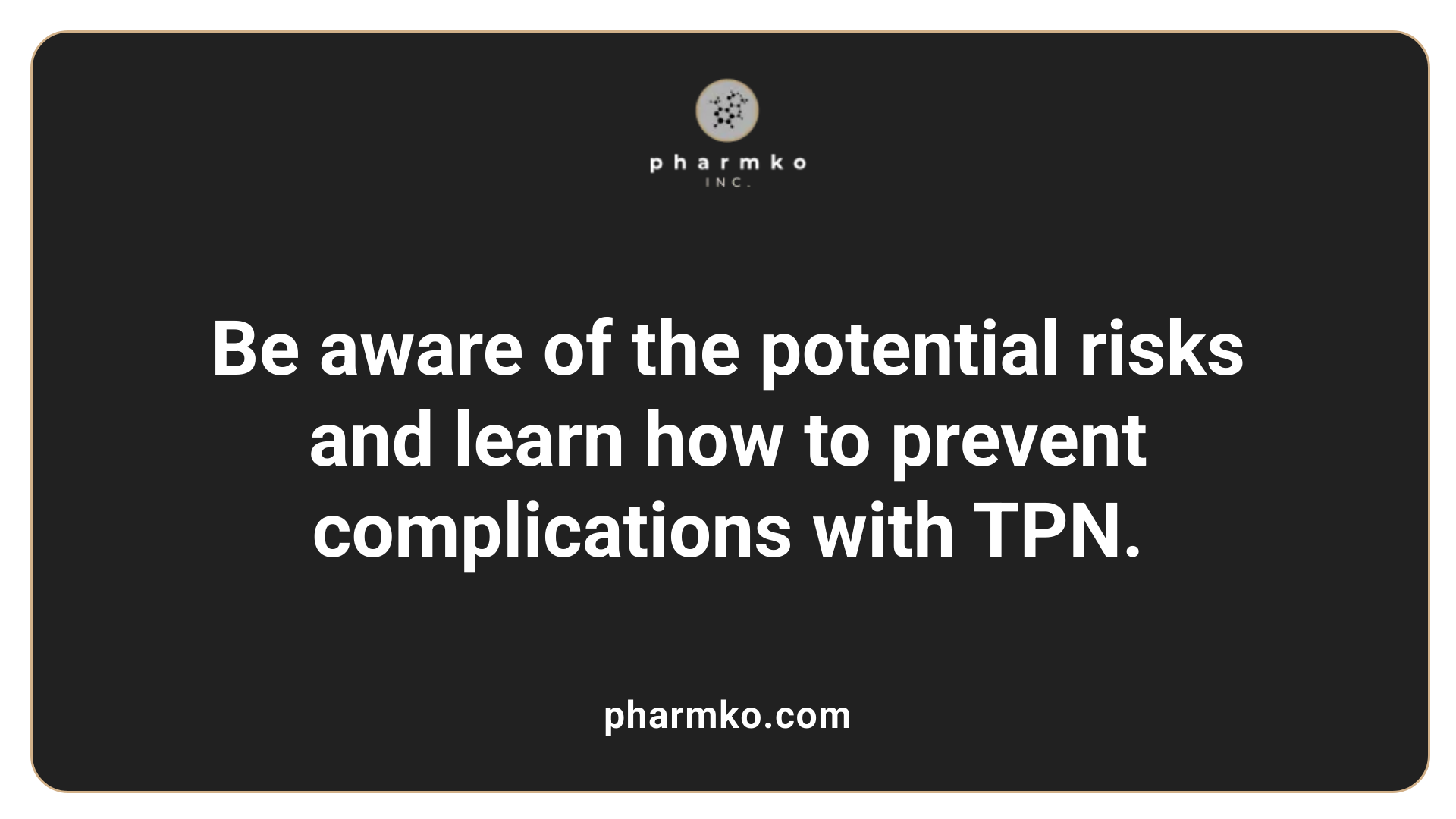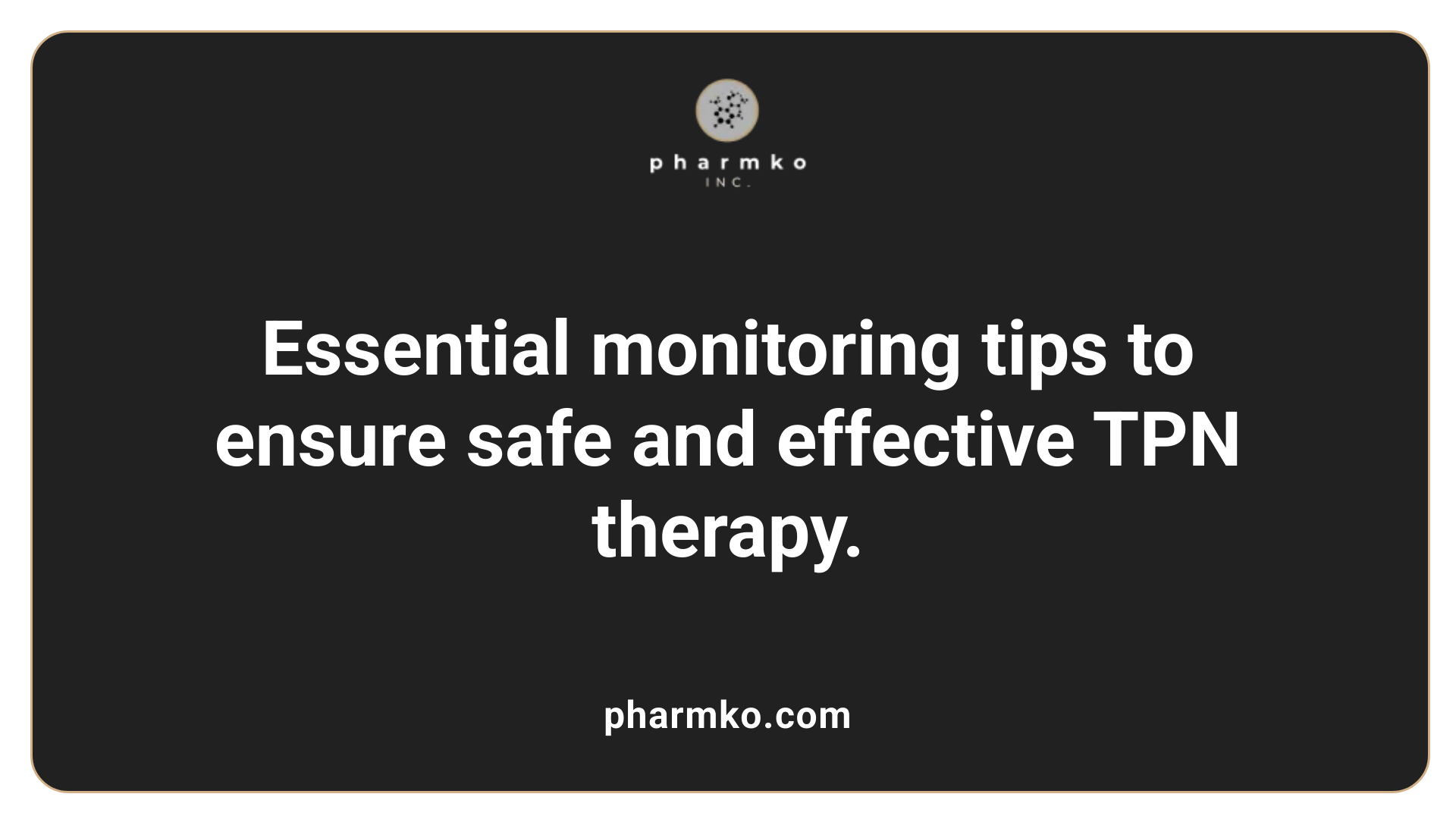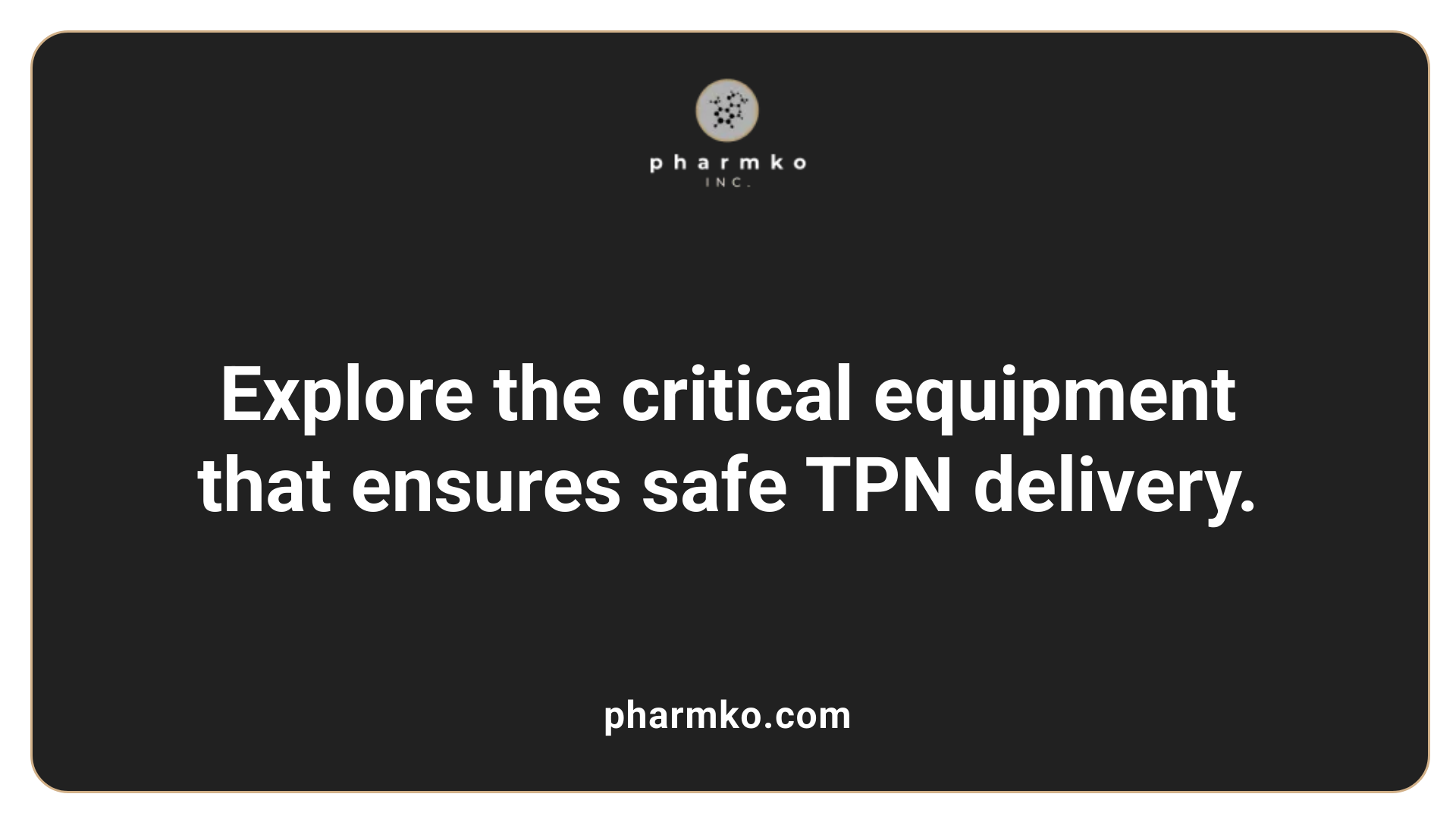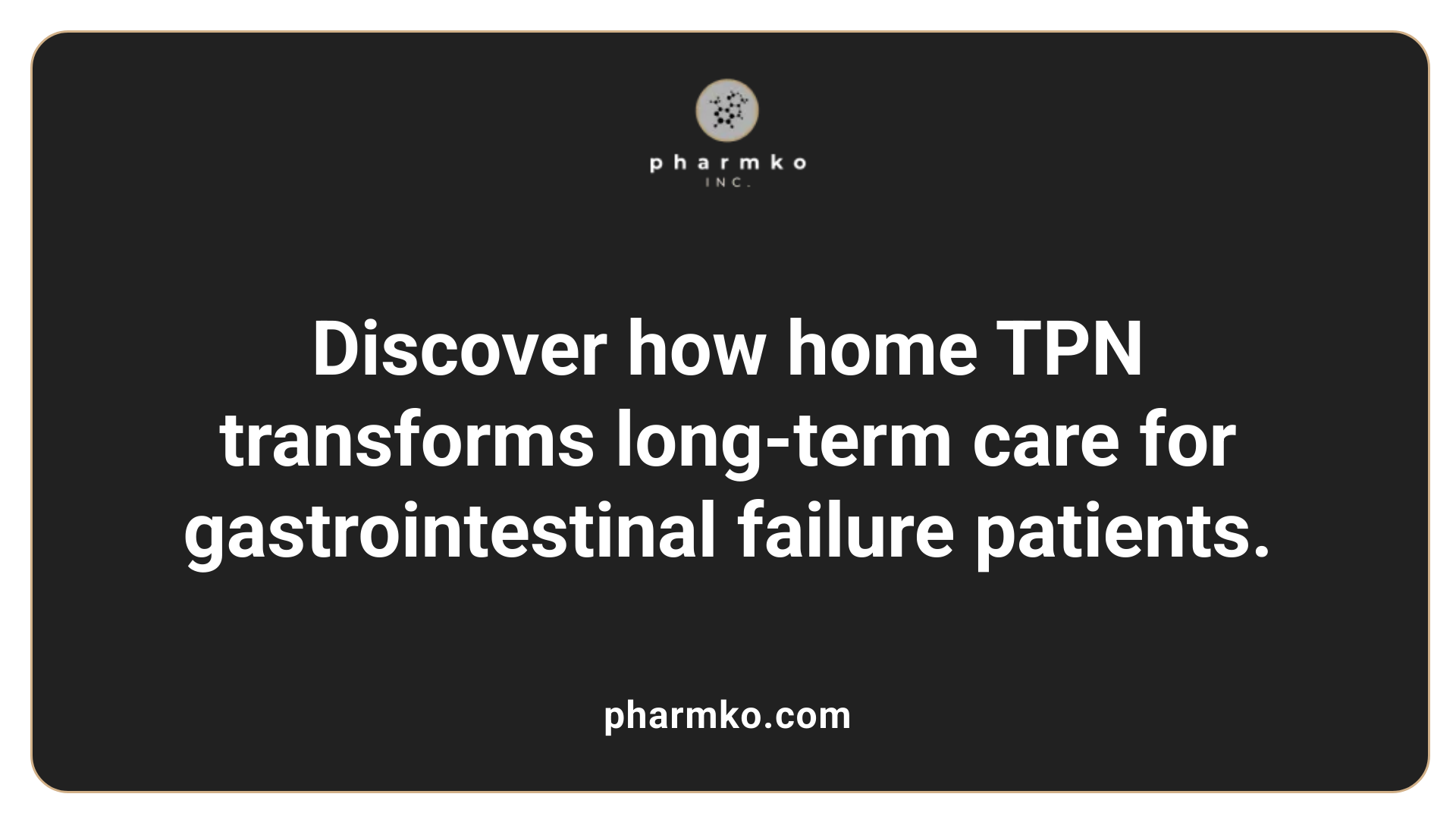Understanding Total Parenteral Nutrition: A Comprehensive Guide
Introduction to Total Parenteral Nutrition (TPN)
Total Parenteral Nutrition (TPN) is a vital medical intervention that delivers essential nutrients directly into a patient's bloodstream when the gastrointestinal (GI) tract cannot be used effectively. Developed in the 1960s, TPN has revolutionized care for individuals with severe gastrointestinal dysfunction, providing a lifeline for maintaining nutritional health and promoting recovery. This comprehensive guide covers the fundamental aspects of TPN, including its definition, clinical applications, components, administration protocols, risks, monitoring, safety standards, and practical considerations for home care.
Defining Total Parenteral Nutrition (TPN)
What is total parenteral nutrition (TPN)?
Total parenteral nutrition (TPN) is an intravenous method of providing essential nutrients directly into the bloodstream. It is used when the gastrointestinal (GI) tract cannot be used effectively for digestion and absorption, due to reasons such as severe illness, surgery, or various gastrointestinal disorders. TPN supplies the body with a balanced mix of carbohydrates, proteins, fats, vitamins, minerals, electrolytes, and fluids, all prepared in sterile solutions.
How TPN bypasses the gastrointestinal tract
Unlike oral or enteral feeding, TPN completely bypasses the GI system. It involves inserting a central venous catheter into a large vein, often near the heart, to deliver nutrients continuously or intermittently. Because the solutions are hypertonic, they are administered through central lines, such as PICC lines, tunneled catheters, or implantable ports, ensuring proper absorption and minimizing vein irritation.
Purpose and goals of TPN
The primary goal of TPN is to prevent or correct nutritional deficiencies when normal eating or enteral feeding isn’t possible. It supports healing, maintains energy levels, and prevents weight loss and muscle wasting in critically ill patients or those with chronic gastrointestinal issues.
Table 1: Summary of TPN Aspects
| Aspect | Details | Purpose/Significance |
|---|---|---|
| Composition | Carbohydrates (dextrose), lipids (fats), amino acids (protein), vitamins, minerals, electrolytes, water | Provides comprehensive nutrition needed for tissue repair, immune function, and energy |
| Administration route | Central venous access device | Ensures high concentration solutions can be safely infused without damaging peripheral veins |
| Monitoring | Electrolyte levels, blood glucose, liver and kidney function, infection signs | Prevents complications like electrolyte imbalances, infections, or metabolic disturbances |
| Duration | Short-term or long-term use, tailored to condition | Supports recovery or sustained nutritional support when necessary |
Additional considerations
Administering TPN requires a multidisciplinary team including healthcare providers, pharmacists, dietitians, and nurses to ensure safety and effectiveness. Proper sterile techniques, regular blood testing, and vigilant monitoring are vital, as risks include infections, liver issues, and metabolic imbalances.
Clinical Indications and Uses of TPN
What are the indications and clinical uses of TPN?
Total parenteral nutrition (TPN) is primarily used for patients who are unable to fulfill their nutritional requirements through oral intake or enteral feeding methods due to various gastrointestinal issues or contraindications. TPN becomes essential when the gastrointestinal (GI) tract cannot be used effectively or safely.
Common conditions that necessitate TPN include short bowel syndrome, where significant portions of the intestine are absent or nonfunctional; bowel obstructions, which prevent food passage; severe malabsorption syndromes such as Crohn’s disease or intestinal failure; and gastrointestinal fistulas that leak digestive fluids, making normal feeding risky.
Post-operative gut rest is another common indication, especially after abdominal surgeries to promote healing. Critically ill patients experiencing hypercatabolic states due to sepsis, trauma, or burns might also require TPN to support their increased metabolic demands.
In neonatal and pediatric care, TPN is used for infants with congenital GI malformations, prematurity-related issues, or failure to thrive, ensuring they receive necessary nutrients during critical developmental periods.
Overall, TPN supplies complete nutrition intravenously, providing essential calories, proteins, vitamins, and minerals. It sustains patients who cannot use their digestive systems effectively, supporting recovery, growth, and ongoing health in various life-threatening or long-term GI conditions.
This therapy plays a crucial role in ensuring nutritional adequacy when enteral feeding is impossible or contraindicated, contributing significantly to patient outcomes in complex clinical scenarios.
Components and Composition of TPN
What are the components of TPN?
Total Parenteral Nutrition (TPN) is a comprehensive intravenous formula designed to supply all necessary nutrients to patients who cannot feed through their gastrointestinal tract. Its components include carbohydrates, proteins, fats, vitamins, minerals, electrolytes, and water.
The primary energy sources in TPN are dextrose (a form of sugar) and lipid emulsions (fats). Dextrose provides the main caloric intake needed for energy, while lipids supply essential fatty acids necessary for cell function and energy storage. Proteins are supplied via amino acids that support tissue repair, growth, and immune function.
In addition to macronutrients, TPN includes various micronutrients. Vitamins and trace elements are added to prevent deficiencies and support metabolic processes, alongside specific electrolytes such as potassium, magnesium, phosphate, and calcium to maintain fluid and electrolyte balance.
How is TPN customized based on patient needs?
The composition of TPN is carefully tailored to each patient's individual requirements. Factors influencing customization include age, weight, clinical condition, metabolic needs, and laboratory results. For example, pediatric patients or malnourished adults may require different proportions of nutrients compared to those with specific metabolic disorders.
Healthcare professionals determine the caloric needs and adjust the nutrient concentrations accordingly. The solutions are formulated in hospital pharmacies or prepared commercially, then bacterial and fungal contamination are prevented through sterile compounding practices.
What are common additives and medications used in TPN?
To optimize the nutritional support, healthcare providers sometimes add medications or supplements directly into the TPN bag. These may include insulin for blood sugar regulation, multivitamins for daily nutritional support, or medications like famotidine and octreotide to manage gastrointestinal secretions or other conditions.
Additives are introduced just before infusion under strict aseptic conditions and require thorough mixing. Proper procedures are essential to prevent incompatibilities and ensure the safety and efficacy of the TPN.
| Component Type | Examples/Details | Additional Information |
|---|---|---|
| Macronutrients | Dextrose (carbohydrates), amino acids (protein), lipids (fats) | Main energy sources, customized doses |
| Micronutrients | Vitamins, trace elements, electrolytes | Prevent deficiencies, support metabolism |
| Medications | Insulin, famotidine, octreotide | To manage glycemia and gastrointestinal conditions |
| Fluid | Water, to meet hydration needs | Adjusted based on patient’s fluid balance |
This detailed composition and customization make TPN a vital nutritional tool for patients with complex medical needs, ensuring they receive vital nutrients directly into their bloodstream.
Administration of TPN: Techniques and Equipment
How is TPN administered?
TPN is given through a large vein using specialized devices called venous access devices. These include central venous catheters such as Peripherally Inserted Central Catheters (PICC lines), tunneled catheters, or implantable ports. Because TPN solutions are hyperosmolar, they require central access for safe infusion.
The administration process involves attaching the prepared TPN solution to an infusion set connected to the catheter. An infusion pump is typically used to control the flow rate, ensuring the patient receives a steady, precise amount of nutrients over the scheduled duration.
Depending on the patient's condition, TPN can be infused continuously over 24 hours or intermittently in cycles. The use of pumps with flow regulation capabilities allows healthcare providers to tailor the infusion to meet individual energy and nutritional needs.
Venous access devices
Selection of the appropriate venous device is crucial. PICC lines are common for long-term therapy, while centrally inserted catheters are preferred for critically ill patients. All devices require strict aseptic technique during insertion and maintenance to minimize infection risks.
Infusion pumps and flow control
Modern infusion pumps ensure accurate delivery and help manage potential complications like hyperglycemia or electrolyte imbalance. These devices often feature alarms to alert staff to issues such as occlusion or disconnection.
Preparation and handling
Preparation of TPN solutions involves sterile compounding, typically done by trained pharmacy staff. The solutions are stored refrigerated until use, then warmed to room temperature before administration to prevent discomfort and ensure stability.
Strict aseptic procedures are followed during setup to prevent bloodstream infections. Careful handling of the infusion set and secure connection to the catheter are essential steps. Regular monitoring during infusion includes checking for signs of complications such as redness, swelling, or leakage at the insertion site.
Proper training of healthcare providers and caregivers on setup, administration, and troubleshooting of TPN equipment is vital for safe therapy. Frequent reassessment of the catheter site and timely intervention when issues arise help optimize outcomes.
This structured approach to administering TPN aligns with best practices aimed at minimizing risks and ensuring the patient's nutritional needs are efficiently met.
Risks and Complications of TPN Therapy

What are the risks and complications associated with TPN?
While TPN is a vital nutritional support for patients unable to use their gastrointestinal tract, it comes with certain risks that require careful management. The most common issue involves infections, especially bloodstream infections that can occur if the line or catheter becomes contaminated. These line-related infections may lead to serious complications if not promptly treated.
In addition to infections, TPN can cause metabolic disturbances. Patients may experience electrolyte imbalances, such as abnormal levels of potassium, magnesium, or sodium, which need regular monitoring and adjustment of the formula. Hyperglycemia or hypoglycemia may also develop, particularly if blood sugar levels are not carefully controlled.
Liver and gallbladder issues are other significant concerns. Long-term TPN therapy can lead to liver dysfunction, including cholestasis and fatty liver disease, potentially progressing to more severe hepatobiliary problems. Gallbladder stasis and stones may also develop due to decreased gallbladder motility.
Other potential adverse effects include metabolic bone disease, caused by calcium and phosphate imbalances, and complications related to the catheter such as thrombosis or mechanical issues. Proper aseptic techniques, vigilant monitoring, and regular assessments are crucial to minimize these risks and ensure safe TPN therapy.
Monitoring and Managing Patients on TPN

How should patients receiving TPN be monitored and managed?
Patients on total parenteral nutrition (TPN) need careful and continuous monitoring to ensure safety and effectiveness. This includes regular laboratory tests and clinical assessments.
Laboratory assessments include checking blood glucose levels frequently to prevent hyperglycemia or hypoglycemia. Electrolytes such as potassium, magnesium, and calcium are monitored to avoid imbalances that could lead to cardiac or neuromuscular issues.
Liver function tests are essential because long-term TPN can cause liver complications, including cholestasis. Monitoring renal function helps ensure proper fluid and electrolyte balance.
Clinically, signs of infection at the catheter site or systemic infection are watched closely, as bloodstream infections are serious risks associated with TPN.
Adjustments to the TPN formula are made based on these lab results and clinical observations. For example, if blood glucose levels are high, insulin may be added, or the carbohydrate content reduced.
In addition to labs, healthcare providers observe the patient for symptoms like swelling, changes in skin color, or signs of metabolic disturbances. This vigilant approach helps catch problems early and tailor the nutritional support to the individual’s needs.
Overall, close multidisciplinary management involving clinicians, pharmacists, and nurses ensures safe TPN therapy and optimal patient outcomes.
Safety Guidelines and Best Practices for TPN Use
What safety considerations and guidelines should be followed when using TPN?
Administering Total Parenteral Nutrition (TPN) requires strict adherence to safety protocols to prevent complications like infections, line dislodgement, or metabolic disturbances.
Aseptic technique is fundamental throughout the entire process. During preparation, healthcare professionals must perform hand hygiene and wear sterile gloves and clothing to maintain a sterile environment. TPN solutions should be prepared in designated clean areas, ideally in laminar airflow hoods, to reduce contamination risk.
Proper storage of TPN components is essential. Solutions should be kept refrigerated until use and checked for correct labeling, expiration dates, leaks, or signs of contamination before administration. When additives like vitamins or medications are included, sterile procedures must be followed to prevent introducing pathogens.
Monitoring the infusion process is equally important. The infusion rate should be carefully controlled using calibrated infusion pumps, and line patency should be maintained with regular line flushing protocols. Securement devices prevent accidental dislodgement of catheters. Regular line care, including disinfecting insertion sites, helps reduce infection risks.
Close observation for signs of adverse effects is necessary. Increased blood sugar levels, electrolyte imbalances, or signs of infection such as redness or swelling at the catheter site should prompt immediate intervention. Routine blood tests help detect metabolic abnormalities early.
Patient and caregiver education plays a critical role. They should be instructed on proper line care, personal hygiene, signs of complications, and emergency procedures. Proper disposal of used supplies and adherence to infection control guidelines ensure safety at all stages.
Overall, a multidisciplinary team approach involving clinicians, pharmacists, nurses, and dietitians ensures protocols are followed, optimizing patient safety and TPN effectiveness.
Equipment Involved in TPN Administration
 The administration of total parenteral nutrition (TPN) requires a variety of specialized equipment to ensure safety and effectiveness. Central venous access devices, such as a peripherally inserted central catheter (PICC line), tunneled catheter, or implantable port, are used to deliver the solution directly into a large vein. This access is essential because TPN solutions are hypertonic and need to be administered through a central line.
The administration of total parenteral nutrition (TPN) requires a variety of specialized equipment to ensure safety and effectiveness. Central venous access devices, such as a peripherally inserted central catheter (PICC line), tunneled catheter, or implantable port, are used to deliver the solution directly into a large vein. This access is essential because TPN solutions are hypertonic and need to be administered through a central line.
The IV setup includes sterile tubing specifically designed for TPN delivery. These infusion sets often contain special filters that trap particulates and bacteria, maintaining the sterility of the solution as it enters the bloodstream. The infusion pump is another vital component; it controls the flow rate of the TPN, ensuring that nutrients are delivered steadily and safely over hours. The pump is typically attached to an IV pole or hook for easy hanging and mobility.
In addition, supplies for line care are crucial. This includes alcohol wipes for disinfecting the connection and insertion sites, syringes for medication additions, dressing supplies like sterile gauze and tape, and sharps containers for safe disposal of used needles and syringes. Regular maintenance with these supplies helps prevent infections and line complications.
Monitoring devices are also used to track infusion parameters, patient vitals, and safety alerts. Proper aseptic techniques during setup, connection, and disconnection are essential to prevent bloodstream infections and other complications. Overall, the equipment involved in TPN administration is designed to maximize safety, maintain sterility, and ensure precise nutrient delivery.
For additional information, searching “TPN equipment and supplies” or “infusion setup for TPN” can provide detailed visuals and guidelines on proper setup and maintenance practices.
Care Considerations for Patients Receiving TPN at Home
Managing TPN at home requires careful attention to several important aspects to ensure safety and effectiveness.
A key focus is catheter hygiene and site care. Patients and caregivers must follow strict aseptic techniques when cleaning and changing dressings around the central line. Regular handwashing, disinfecting the access site, and monitoring for signs of infection—such as redness, swelling, or discharge—are essential to prevent bloodstream infections.
Proper training is vital. Healthcare professionals should educate patients and caregivers on sterile preparation and handling of TPN solutions, infusion pumps, and equipment. Instructions should include how to set up the infusion correctly, check for cloudiness or particles in the solution, and recognize early signs of complications.
Monitoring for complications is another critical aspect. Patients should be vigilant for symptoms like fever, chills, unexplained pain, or swelling at the catheter site. Any abnormal signs should prompt immediate contact with healthcare providers. Regular blood tests help assess electrolyte balance, liver function, and nutritional status to detect issues early.
Storage and handling of TPN supplies must not be overlooked. TPN solutions should be stored in the refrigerator until use and brought to room temperature before infusion. The environment for preparation should be clean and free from contaminants. Ensuring proper labeling, secure connections, and correct disposal of waste further support safety during home administration.
Overall, a multidisciplinary team, including clinicians, nurses, and dietitians, provides ongoing support, education, and monitoring. These combined efforts help maintain optimal nutrition, prevent complications, and enhance the patient’s quality of life while receiving TPN therapy at home.
Long-term Outlook and Patient Outcomes with TPN

What are the benefits and expected outcomes of TPN therapy?
Total Parenteral Nutrition (TPN) provides vital nutrients directly into the bloodstream for patients who cannot obtain sufficient nutrition through their gastrointestinal system. Its primary benefit is maintaining or improving nutritional status, which is essential for wound healing, immune function, and overall recovery.
TPN is often used in cases of severe gastrointestinal impairment, post-surgical recovery, or chronic malnutrition. It helps correct nutritional deficiencies, prevents weight loss, and supports growth in pediatric patients. When properly managed, TPN can reduce complications related to malnutrition, such as muscle wasting and immune suppression.
The anticipated results of TPN therapy include enhanced tissue repair, improved energy levels, and stabilization of metabolic functions. Many patients experience a significant boost in overall health and strength.
Monitoring laboratory parameters like electrolytes, liver function, and blood glucose is critical to tailoring the therapy and avoiding adverse effects such as infections or liver complications.
Over time, some patients may recover enough gastrointestinal function to transition back to enteral or oral feeding, reducing dependence on TPN. For others with chronic conditions, TPN remains a sustained but manageable nutritional support.
In summary, TPN can be a life-saving intervention that leads to improved nutritional and health outcomes when integrated into a comprehensive care plan, ensuring safety and efficacy through continuous monitoring and adjustment.
Overview of Home Parenteral Nutrition (HPN) and Long-term Management
 Home parenteral nutrition (HPN), also known as long-term TPN, provides essential nutrients directly into the bloodstream for patients with severe gastrointestinal dysfunction who cannot meet their nutritional needs through conventional eating or enteral feeding.
Home parenteral nutrition (HPN), also known as long-term TPN, provides essential nutrients directly into the bloodstream for patients with severe gastrointestinal dysfunction who cannot meet their nutritional needs through conventional eating or enteral feeding.
Unlike inpatient TPN, which is administered in a controlled hospital setting, HPN allows patients to receive nutrition therapy at home, supporting better quality of life, independence, and the ability to participate in daily activities, work, and travel.
The equipment used for HPN includes a central venous catheter—such as a tunneled catheter, implanted port, or PICC line—that provides direct access to a large vein near the heart. The TPN solutions are customized based on individual requirements, considering factors like age, weight, diagnosis, and laboratory results. These solutions consist of macronutrients like dextrose, amino acids, and lipids, along with vitamins, minerals, and electrolytes.
Proper environmental and safety considerations are critical for home TPN. This involves maintaining a sterile environment to prevent infections, proper storage of TPN supplies—usually refrigerated—and careful handling during preparation and infusion. Patients and caregivers must be trained extensively by healthcare professionals on sterile techniques, including dressing changes, connection procedures, and troubleshooting.
Patients on home TPN play integral roles in their care, including monitoring for signs of infection or line complications, maintaining aseptic technique during bag changes, and managing infusion schedules. Caregivers also need to be prepared to assist with urgent issues, such as line dislodgement or signs of metabolic disturbances.
Regular follow-up with a multidisciplinary team—comprising physicians, nurses, pharmacists, and dietitians—is essential to monitor nutritional status, laboratory parameters, and overall health. Adjustments to the TPN formulation may be necessary over time to optimize therapy and prevent complications like liver dysfunction, glucose imbalances, or electrolyte disturbances.
In summary, long-term home TPN provides a life-sustaining option that requires careful planning, education, and ongoing clinical oversight to ensure safety and quality of life for patients with complex nutritional needs.
Concluding Remarks on TPN
Total Parenteral Nutrition remains a cornerstone life-saving therapy for individuals unable to use their gastrointestinal tract effectively. Its success depends on meticulous preparation, vigilant monitoring, adherence to safety protocols, and dedicated patient and caregiver management, especially in the home setting. Advances continue to enhance the safety and efficacy of TPN, enabling better quality of life and health outcomes. As research progresses, the goal remains to optimize nutritional support with minimal risks, ensuring that patients receive the maximum benefits from this essential therapy.
References
- Total Parenteral Nutrition - StatPearls - NCBI Bookshelf
- Parenteral Nutrition: What it Is, Uses & Types - Cleveland Clinic
- Parenteral Nutrition Overview - PMC - PubMed Central
- [PDF] Total Parenteral Nutrition: Home Care Guide - Northwestern Medicine
- Understanding Parenteral Nutrition
- Home Total Parenteral Nutrition (TPN)
- 8.8 Total Parenteral Nutrition (TPN) – Clinical Procedures for Safer ...













